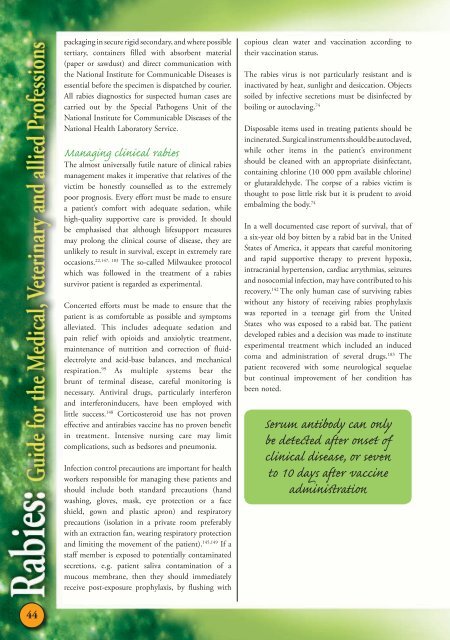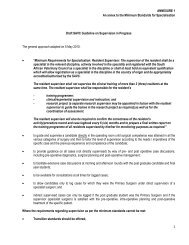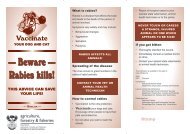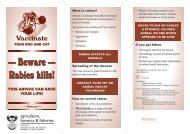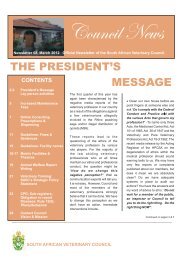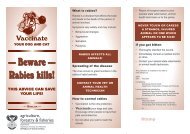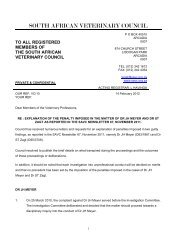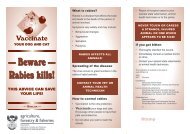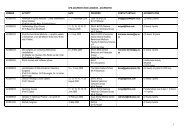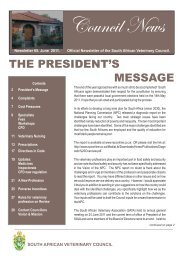Rabies Guide 2010.pdf - the South African Veterinary Council
Rabies Guide 2010.pdf - the South African Veterinary Council
Rabies Guide 2010.pdf - the South African Veterinary Council
You also want an ePaper? Increase the reach of your titles
YUMPU automatically turns print PDFs into web optimized ePapers that Google loves.
packaging in secure rigid secondary, and where possible<br />
tertiary, containers filled with absorbent material<br />
(paper or sawdust) and direct communication with<br />
<strong>the</strong> National Institute for Communicable Diseases is<br />
essential before <strong>the</strong> specimen is dispatched by courier.<br />
All rabies diagnostics for suspected human cases are<br />
carried out by <strong>the</strong> Special Pathogens Unit of <strong>the</strong><br />
National Institute for Communicable Diseases of <strong>the</strong><br />
National Health Laboratory Service.<br />
Managing clinical rabies<br />
The almost universally futile nature of clinical rabies<br />
management makes it imperative that relatives of <strong>the</strong><br />
victim be honestly counselled as to <strong>the</strong> extremely<br />
poor prognosis. Every effort must be made to ensure<br />
a patient’s comfort with adequate sedation, while<br />
high-quality supportive care is provided. It should<br />
be emphasised that although lifesupport measures<br />
may prolong <strong>the</strong> clinical course of disease, <strong>the</strong>y are<br />
unlikely to result in survival, except in extremely rare<br />
occasions. 22,147, 183 The so-called Milwaukee protocol<br />
which was followed in <strong>the</strong> treatment of a rabies<br />
survivor patient is regarded as experimental.<br />
Concerted efforts must be made to ensure that <strong>the</strong><br />
patient is as comfortable as possible and symptoms<br />
alleviated. This includes adequate sedation and<br />
pain relief with opioids and anxiolytic treatment,<br />
maintenance of nutrition and correction of fluidelectrolyte<br />
and acid-base balances, and mechanical<br />
respiration. 99 As multiple systems bear <strong>the</strong><br />
brunt of terminal disease, careful monitoring is<br />
necessary. Antiviral drugs, particularly interferon<br />
and interferoninducers, have been employed with<br />
little success. 148 Corticosteroid use has not proven<br />
effective and antirabies vaccine has no proven benefit<br />
in treatment. Intensive nursing care may limit<br />
complications, such as bedsores and pneumonia.<br />
Infection control precautions are important for health<br />
workers responsible for managing <strong>the</strong>se patients and<br />
should include both standard precautions (hand<br />
washing, gloves, mask, eye protection or a face<br />
shield, gown and plastic apron) and respiratory<br />
precautions (isolation in a private room preferably<br />
with an extraction fan, wearing respiratory protection<br />
and limiting <strong>the</strong> movement of <strong>the</strong> patient). 145,149 If a<br />
staff member is exposed to potentially contaminated<br />
secretions, e.g. patient saliva contamination of a<br />
mucous membrane, <strong>the</strong>n <strong>the</strong>y should immediately<br />
receive post-exposure prophylaxis, by flushing with<br />
copious clean water and vaccination according to<br />
<strong>the</strong>ir vaccination status.<br />
The rabies virus is not particularly resistant and is<br />
inactivated by heat, sunlight and desiccation. Objects<br />
soiled by infective secretions must be disinfected by<br />
boiling or autoclaving. 74<br />
Disposable items used in treating patients should be<br />
incinerated. Surgical instruments should be autoclaved,<br />
while o<strong>the</strong>r items in <strong>the</strong> patient’s environment<br />
should be cleaned with an appropriate disinfectant,<br />
containing chlorine (10 000 ppm available chlorine)<br />
or glutaraldehyde. The corpse of a rabies victim is<br />
thought to pose little risk but it is prudent to avoid<br />
embalming <strong>the</strong> body. 74<br />
In a well documented case report of survival, that of<br />
a six-year old boy bitten by a rabid bat in <strong>the</strong> United<br />
States of America, it appears that careful monitoring<br />
and rapid supportive <strong>the</strong>rapy to prevent hypoxia,<br />
intracranial hypertension, cardiac arrythmias, seizures<br />
and nosocomial infection, may have contributed to his<br />
recovery. 142 The only human case of surviving rabies<br />
without any history of receiving rabies prophylaxis<br />
was reported in a teenage girl from <strong>the</strong> United<br />
States who was exposed to a rabid bat. The patient<br />
developed rabies and a decision was made to institute<br />
experimental treatment which included an induced<br />
coma and administration of several drugs. 183 The<br />
patient recovered with some neurological sequelae<br />
but continual improvement of her condition has<br />
been noted.<br />
Serum antibody can only<br />
be detected after onset of<br />
clinical disease, or seven<br />
to 10 days after vaccine<br />
administration<br />
44


